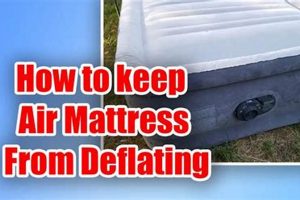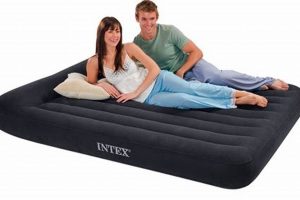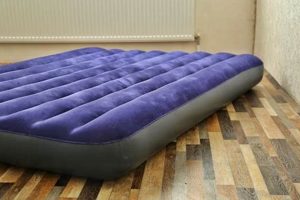Elevated inflatable sleeping surfaces combine the comfort of an air-filled mattress with the convenience of a raised platform. This type of bedding solution often consists of a durable air chamber supported by a foldable or otherwise easily assembled frame. An example would be a self-inflating mattress placed atop a metal or composite stand, providing a sleeping arrangement higher off the ground than a traditional air mattress alone.
The primary advantages of utilizing a raised inflatable bed include improved accessibility for individuals with mobility limitations and increased comfort due to the elevation. Elevation also assists in temperature regulation and avoids close contact with cold floors. Historically, temporary sleeping solutions like these have been utilized for accommodating guests, camping, and situations where space is limited or permanent bed frames are impractical.
Understanding the components, inflation mechanisms, suitability for diverse needs, and proper maintenance of these sleeping solutions is essential for making informed purchasing decisions. The following sections will delve into these specific aspects, providing detailed information to assist in selecting and utilizing these beds effectively.
Tips for Optimal Use
Maximizing the lifespan and utility of an elevated inflatable bed requires careful consideration of several key factors. These tips outline best practices for setup, maintenance, and responsible use.
Tip 1: Select a Level Surface. Prior to inflation and assembly, ensure the intended location is free from debris and provides a stable, level foundation. Uneven surfaces can compromise structural integrity and lead to premature wear or failure.
Tip 2: Adhere to Weight Limits. Exceeding the manufacturer-specified weight capacity can damage the support frame and the air chamber. Distribute weight evenly across the surface whenever possible.
Tip 3: Regulate Inflation Pressure. Avoid over-inflation, as this can place undue stress on the seams and lead to ruptures. Follow the manufacturer’s instructions regarding optimal inflation levels. Using a dedicated pressure gauge is recommended.
Tip 4: Protect Against Punctures. Keep sharp objects away from the inflated surface. Use a mattress protector to provide an additional layer of defense against accidental punctures or tears.
Tip 5: Store Properly When Not in Use. Deflate completely, clean the surface, and store the air mattress and stand in a dry, cool environment away from direct sunlight. This prevents degradation of the materials.
Tip 6: Inspect Regularly for Damage. Periodically examine the air mattress and stand for signs of wear, such as leaks, tears, or weakened joints. Address any issues promptly to prevent further damage and maintain safe usage.
Adhering to these recommendations ensures the durability and functionality of an elevated inflatable bed, providing reliable comfort and support for extended periods.
With these tips in mind, the reader is better prepared to use and maintain their bed effectively. The article will now explore common issues and troubleshooting techniques.
1. Elevated sleeping surface
The elevated sleeping surface is a defining characteristic of an air mattress on a stand, distinguishing it from standard, floor-level air mattresses. The stand raises the inflatable mattress off the ground, offering several functional advantages. This elevation directly contributes to ease of access, particularly for individuals with mobility constraints, by reducing the distance required to sit or stand from the sleeping position. In effect, the elevated surface mitigates strain on joints and muscles, fostering a more comfortable and accessible rest experience. A real-world example can be found in temporary housing situations or in homes where space is limited; the elevated air mattress provides a bed-height comfort level similar to a conventional bed, making it suitable for both short-term and extended use.
Further contributing to the practical significance is the enhanced air circulation provided by the elevated design. Raising the mattress allows for greater airflow around all sides, mitigating the build-up of moisture and regulating temperature. This is particularly important in environments with poor ventilation or where floor temperatures are consistently low. The elevated aspect also serves to separate the sleeper from potential floor-level allergens and dust, contributing to improved air quality. This increased ventilation can be especially beneficial to users sensitive to temperature.
In summary, the elevated sleeping surface is not merely an aesthetic feature, but a crucial element contributing to the overall functionality and comfort of an air mattress on a stand. The elevation impacts accessibility, thermal regulation, and air quality. Understanding this connection allows consumers to make informed decisions based on their specific needs and priorities, ensuring that the selected sleeping solution provides both comfort and practical benefits. A challenge, however, is to ensure the sturdiness of the stand itself, addressing concerns about stability and weight capacity, issues that affect the overall safety and usability of the elevated system.
2. Enhanced postural support
The relationship between elevated inflatable beds and enhanced postural support is multi-faceted, hinging on design elements and proper usage. While the inherent nature of an air mattress might suggest a lack of support compared to traditional innerspring mattresses, specific design features and the inclusion of a supportive stand aim to mitigate this. The degree to which postural support is enhanced depends on factors such as the internal construction of the air mattress (e.g., coil beam or I-beam design), the quality of the materials, and the stability of the supporting stand. An unstable stand undermines any potential benefit from a well-designed air chamber. For example, an air mattress with internal vertical beams, when properly inflated on a rigid stand, can distribute weight more evenly, mimicking the support offered by conventional mattresses and minimizing spinal misalignment.
The stand contributes to postural support by providing a firm, level base, preventing sagging and uneven weight distribution, common issues with air mattresses placed directly on the floor. Furthermore, the height afforded by the stand facilitates easier ingress and egress, reducing strain on the back and joints, which indirectly promotes better posture. The proper inflation level is also crucial; an under-inflated mattress offers inadequate support, leading to spinal compression, while over-inflation can result in a rigid surface that does not conform to the body’s natural contours. A practical application is the use of an elevated inflatable bed by individuals recovering from back injuries. When used
correctly, it can provide a comfortable and supportive sleeping surface, aiding in recovery. The use of a mattress topper can also improve postural support.
In conclusion, enhanced postural support from an elevated inflatable bed is contingent upon a confluence of factors: a well-constructed air mattress, a stable and rigid stand, and appropriate inflation. While not inherently superior to traditional mattresses in terms of support, an elevated inflatable bed can provide adequate and even beneficial support when these elements are properly addressed. Ensuring the sturdiness of the frame and the correct inflation level presents the primary challenge in achieving consistent postural support. Future advancements in materials and design may further improve the postural benefits of these beds.
3. Improved thermal regulation
Elevating an air mattress off the floor with a stand directly impacts thermal regulation by creating an air gap between the mattress and the floor surface. This separation mitigates heat transfer, which can be a significant factor in maintaining a comfortable sleeping temperature. Floors, particularly those made of concrete or tile, tend to remain cooler than the ambient air, drawing heat away from anything in direct contact. The presence of a stand disrupts this conductive heat loss, reducing the likelihood of the sleeper experiencing coldness. Similarly, in warmer conditions, the elevated position allows for improved air circulation around the mattress, facilitating convective heat transfer and preventing the build-up of trapped heat. For example, individuals using an air mattress on a stand in a basement environment often report a noticeable improvement in warmth compared to using the same mattress directly on the floor.
The importance of this thermal regulation extends beyond mere comfort; it contributes to sleep quality. Maintaining a stable body temperature throughout the night is essential for achieving restful sleep. Fluctuations in temperature can disrupt sleep cycles and lead to restlessness. By minimizing conductive and convective heat loss or gain, an air mattress on a stand promotes a more stable sleeping environment. This is particularly beneficial for individuals sensitive to temperature changes or those living in climates with extreme temperature variations. A practical application includes using an air mattress on a stand during camping trips. The stand protects the sleeper from the cold ground, maintaining a more consistent temperature and improving sleep quality in outdoor conditions.
In summary, the improved thermal regulation afforded by an air mattress on a stand is a direct consequence of its elevated design. This elevation minimizes heat transfer with the floor and promotes air circulation, contributing to a more stable and comfortable sleeping temperature. While not a complete solution for extreme temperature conditions, the stand provides a tangible improvement in thermal comfort, enhancing sleep quality and overall user satisfaction. A challenge remains in optimizing the stand design to further enhance airflow and minimize conductive heat transfer, potentially through the use of insulating materials or strategic ventilation patterns.
4. Simplified storage solution
The inherent design of an air mattress on a stand lends itself to simplified storage, a characteristic particularly valuable in space-conscious environments. The ease with which the unit can be disassembled and compactly stored addresses a key challenge associated with traditional bedding solutions. Its relevance extends to guest rooms, small apartments, and situations requiring temporary sleeping arrangements.
- Deflation and Folding Efficiency
The primary attribute contributing to simplified storage is the ability to deflate the air mattress, reducing its volume significantly. Simultaneously, the supporting stand is typically designed for disassembly or folding. This combination allows the entire system to be packed into a compact form, often fitting within a dedicated storage bag. For example, when not in use, a queen-sized air mattress on a stand can be deflated, folded, and stored in a closet, minimizing its footprint.
- Reduced Spatial Footprint
Compared to traditional bed frames and mattresses, which occupy a substantial amount of space, an air mattress on a stand, when stored, consumes considerably less volume. This reduction in spatial footprint is particularly advantageous in smaller living spaces where maximizing available area is paramount. Consider a studio apartment where a permanent bed would dominate the room; an air mattress on a stand provides a comfortable sleeping solution that can be easily stored away during the day.
- Portability and Transportability
The simplified storage also enhances portability and transportability. The compact, lightweight nature of the deflated mattress and disassembled stand makes it easier to move the unit from one location to another, a feature useful for temporary relocation or travel. For instance, individuals moving between apartments or needing a temporary bed at a vacation home can easily transport an air mattress on a stand.
- Organized Storage Solutions
Many manufacturers provide dedicated storage bags or containers specifically designed for their air mattress and stand systems. These bags not only protect the components during storage but also contribute to organized storage by keeping all parts together and preventing loss or damage. This organized approach simplifies retrieval and setup when the sleeping solution is needed again.
These facets collectively highlight the simplified storage capabilities of an air mattress on a stand. By offering a sleeping solution that can be easily deflated, disassembled, and compactly stored, this type of bed addresses a key need in space-constrained environments and situations requiring temporary bedding. The compact storage translates to greater flexibility in utilizing living spaces and simplified transport, making it a practical alternative to traditional bed frames and mattresses.
5. Guest accommodation convenience
The provision of comfortable and readily available sleeping arrangements for visitors constitutes a significant aspect of hospitality. An elevated inflatable bed addresses this need with a combination of attributes that contribute to enhanced guest accommodation convenience. The primary driver of this convenience lies in the bed’s ease of deployment and storage, offering a practical alternative to dedicated guest rooms or cumbersome sofa beds. The ability to quickly inflate and set up a comfortable sleeping surface translates to a more streamlined and less disruptive hosting experience. A real-world example is the use of these beds in apartments or homes lacking a designated guest room; the inflatable bed provides a comfortable sleeping solution that can be set up in a living room or study, offering guests a more dignified and private space than a sofa or floor mattress.
Furthermore, the elevated design contributes to guest comfort, mirroring the experience of a conventional bed. The
raised sleeping surface improves accessibility, simplifying ingress and egress, particularly for elderly guests or those with mobility limitations. The inherent portability and self-contained nature of the system, often including a built-in pump and storage bag, further enhance its convenience. Consider a scenario where a family member arrives unexpectedly; an elevated inflatable bed can be deployed within minutes, offering a ready-made sleeping arrangement without the need for extensive preparation or furniture rearrangement. In addition, the hygienic aspects of a fresh, inflatable mattress are often preferred by guests over shared bedding. The quick deflation and storage feature provides immediate clear-up after use.
In summary, the convenience of an air mattress on a stand for guest accommodation is multifaceted, stemming from its ease of setup, comfortable elevated design, portability, and storage efficiency. It represents a practical and readily available solution for hosts seeking to provide comfortable and accommodating sleeping arrangements for visitors, particularly in space-limited environments. A potential challenge lies in ensuring the durability and reliability of the inflation mechanism and stand, as these components are critical to the overall convenience and functionality of the system.
Frequently Asked Questions
This section addresses common inquiries regarding elevated inflatable beds, providing concise and factual answers to enhance understanding and inform purchasing decisions.
Question 1: What is the maximum weight capacity typically supported by an air mattress on stand?
Weight capacity varies significantly based on the specific model and construction. It is imperative to consult the manufacturer’s specifications prior to use. Common weight limits range from 300 to 600 pounds. Exceeding the specified weight limit can result in structural failure and potential injury.
Question 2: How long does it generally take to inflate an air mattress on a stand?
Inflation time depends on the pump type (internal or external) and the mattress size. Internal electric pumps typically inflate a mattress in 3 to 5 minutes. External pumps may require slightly longer. Manual inflation is generally not recommended due to the time and effort involved.
Question 3: What materials are commonly used in the construction of these beds?
Air mattresses are typically constructed from durable PVC or TPU. The stands are often made of steel, aluminum, or reinforced composite materials. The choice of materials impacts the bed’s durability, weight, and overall cost.
Question 4: How should an air mattress on a stand be properly cleaned and maintained?
Regular cleaning with a damp cloth and mild detergent is recommended. Abrasive cleaners should be avoided. Ensure the mattress is completely dry before storing. Periodically inspect the mattress and stand for signs of damage or wear.
Question 5: Can an air mattress on a stand be used outdoors for camping?
While some models are suitable for outdoor use, it is crucial to verify the manufacturer’s recommendations. Outdoor use may require additional precautions, such as using a protective ground sheet to prevent punctures.
Question 6: What is the typical lifespan of an air mattress on a stand?
The lifespan depends on usage frequency, care, and the quality of materials. With proper care, an air mattress on a stand can last for several years. Frequent use and improper storage can shorten its lifespan.
In summary, proper understanding of weight limits, inflation procedures, materials, cleaning methods, outdoor suitability, and expected lifespan is crucial for maximizing the value and longevity of an air mattress on a stand.
The subsequent section will provide information on troubleshooting common issues that may arise with elevated inflatable beds.
Air Mattress on Stand
The preceding analysis has explored the multifaceted aspects of the air mattress on stand, detailing its construction, benefits, limitations, and practical applications. Key considerations encompass ease of use, storage convenience, thermal properties, postural support, and suitability for accommodating guests. A comprehensive understanding of these elements is vital for consumers seeking temporary or adaptable bedding solutions.
In conclusion, the air mattress on stand presents a viable option for those requiring flexible sleeping arrangements, provided that careful consideration is given to factors such as weight capacity, material quality, and proper maintenance. Responsible evaluation of individual needs and adherence to manufacturer guidelines are essential for ensuring both user satisfaction and product longevity. Further advancements in materials and designs will likely continue to refine the performance and utility of the air mattress on stand in the future.





![Best Puncture Resistant Air Mattress [Guide] Comfort Now! Organic & Natural Mattress Buyer’s Guide: Non-Toxic Sleep Solutions Best Puncture Resistant Air Mattress [Guide] Comfort Now! | Organic & Natural Mattress Buyer’s Guide: Non-Toxic Sleep Solutions](https://mattressworldpa.com/wp-content/uploads/2025/07/th-6547-300x200.jpg)

